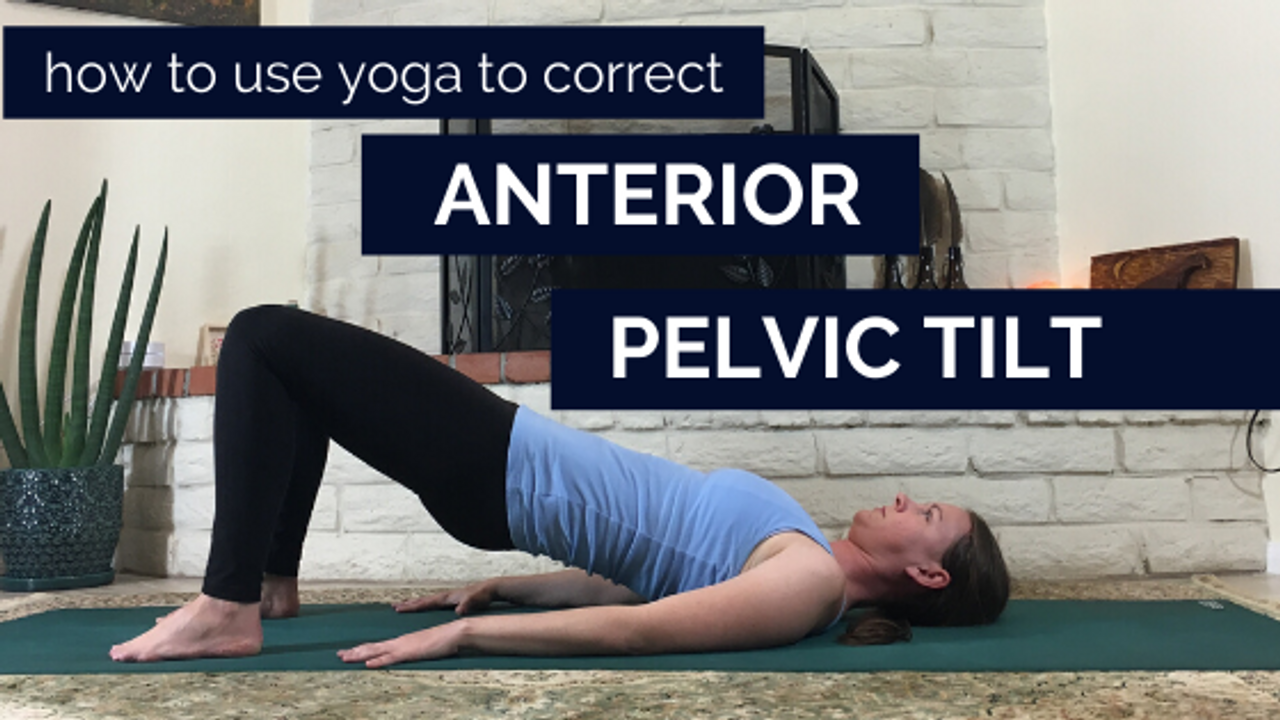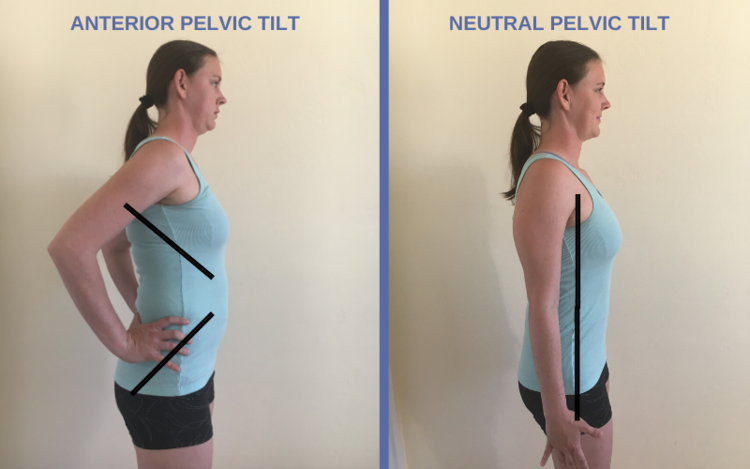How To Use Yoga To Correct Anterior Pelvic Tilt.

I have a confession to make: I have an anterior pelvic tilt.
An anterior pelvic tilt is when the top of the pelvis drops forward and the bottom of the pelvis (tailbone) lifts up behind the body. It can also look like an overly pronounced low back curve, or the belly poofing forward.
Now, to begin, let me say that an anterior pelvic tilt is not necessarily a bad thing. It’s only a bad thing if we’re stuck in the position and cannot recruit engagement to move the pelvis into a neutral position or posterior tilt. Ideally, we want the positioning of our pelvis to be deliberate and moveable.
Anterior Pelvic Tilt Symptoms

When I first started practicing yoga, I wasn’t aware that my pelvis could have a tilt, let alone be stuck in one. I moved through my postures and wondered why my low back hurt afterwards and why I wasn’t seeing the booty-gains my teachers were promising.
Motivated by pain and confusion, I started seeking answers, and I found that I was far from alone. While some people have a pelvis stuck in the opposite position--posterior pelvic tilt--an anterior pelvic tilt is quite common for our population, and there are a few reasons for this.
-
We sit all day long. When we stand up, it’s ideally our glutes (booty muscles) job to push our pelvis into a neutral position and stabilize the pelvis from the back. Think of the glutes job as bringing the bottom of the pelvis (tailbone) forward and holding it there. Sitting all day does not encourage our glutes to do their job or even know what their job is. As a result, many people have trouble firing their glutes.
-
It’s easier to hold our body passively than actively. When we tip the top of the pelvis forward, we put tension along the linea alba, which is a vertical line of soft tissue that connects the ribs to the pelvis and attaches our six-pack muscles off either side. It’s easier for us to put tension on our linea alba and hang there, rather than to recruit muscle activation in the glutes to hold our pelvis in a neutral position.
-
We do a ton of movement with our arms in front of our body (typing, driving, cooking, etc). When we are tight and unbalanced in our shoulders, it has an impact on our rib cage. When the bottom of our rib cage is pitched up (which is a common correction we make to “sit up straight” when we notice we’re slouching), it encourages the top of our pelvis to pitch forward.
Can you see how an anterior pelvic tilt has implications up and down the chain of the body? Weak glutes allow the pelvis to pitch forward, pitching the pelvis forward and the bottom ribs up allows us to hang on our linea alba instead of recruiting muscle activation to hold our body upright.
Anterior Pelvic Tilt Yoga Plan
Yoga has been immensely helpful for me in building awareness of my pelvic position and giving me the tools necessary to position my pelvis deliberately.
If you identify as someone with an anterior pelvic tilt (or a posterior pelvic tilt for that matter!), here are the steps needed to find freedom in your pelvis:
-
Awareness - The first step in realigning the pelvis is to become aware of how you normally position it. Do your frontal hip bones (you can feel those with your fingers, and I suggest you start feeling those puppies during movement so your brain can start mapping that area) spill out in front of you? In what positions do they spill forward? All positions? Lunges? Squats? Wide-legged positions? Taking inventory of your positioning is the first step to making smart changes.
-
Move - Once you have a sense of your pelvic positioning, now you can start playing around with it. Continue to use your hands on your frontal hip bones to map your movements, and in every position you do, try to deliberately rock your pelvis back and forth. Notice where you feel stuck, notice what feels second nature.
-
Find neutral pelvis in a standing position - A neutral pelvis occurs when the frontal hip bones stack vertically over our pubis bone. Our pubis bone is a bone on the front of the pelvis near the bottom, underneath where our underwear sits before the pelvis rounds down to the under carriage. Use your hands to feel around for your pubis bone and position your frontl hip bones directly on top of it. If you feel like you need to use substantial muscle activation to hold the pelvis here (in the glutes or in the front hip muscles), this is a corrective exercise you should do more often, until it feels more second nature.
-
Find neutral pelvis in other positions - Lunges. Squats. Downward facing dog. Wide-legged positions. This will take some time to develop, but it will teach you how to feel for a neutral pelvis when other joints are in more complex positions. Learning to maintain a neutral pelvis in a variety of positions is what will make a neutral pelvis feel more second nature.
Moving Forward
We aren’t trying to banish our anterior pelvic tilt from our lives. We’re only attempting to make it more deliberate. Freedom in our movement occurs When we have access to all ranges of motion and can deliberately control them. We can be free and still present an anterior tilt to the world, as long as it’s on purpose.
About Yoga In Your Living Room
Our yoga platform features smart, simple movements that help you feel better without confusing you, overwhelming you, or asking you to do impossible things. We believe you are capable of moving well, resolving pain, overcoming obstacles, and feeling capable beyond your wildest dreams. Try our online yoga membership risk-free for 7-days, or subscribe to our mailing list to stay in touch.


